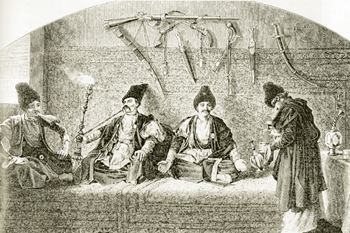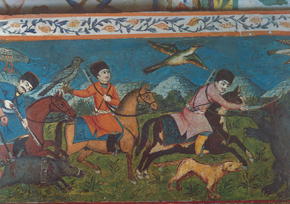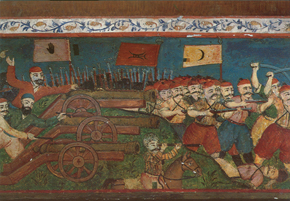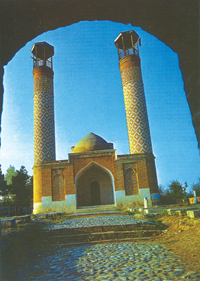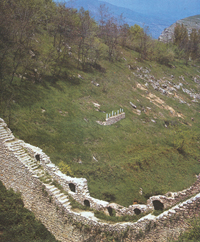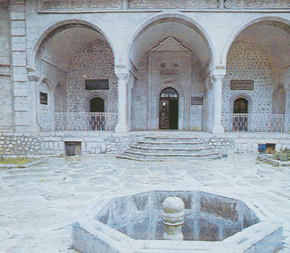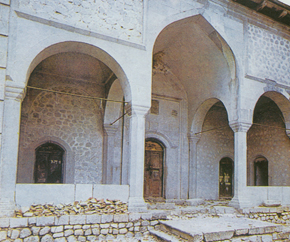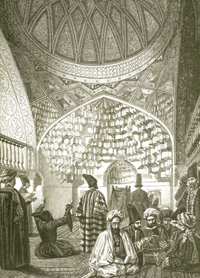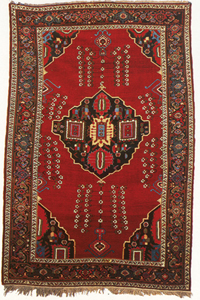Pages 34-42
by Academician Mahmud Ismayilov
The complex political situation in the late 18th and early 19th centuries in Azerbaijan rendered the independent existence of the khanates untenable. They had to choose between absorption into Iran, Turkey or Russia, each of which had its own interests in Azerbaijan. At the start of the 19th century Russia was especially active in pursuing its economic and political concerns in the South Caucasus.
by Academician Mahmud Ismayilov
The complex political situation in the late 18th and early 19th centuries in Azerbaijan rendered the independent existence of the khanates untenable. They had to choose between absorption into Iran, Turkey or Russia, each of which had its own interests in Azerbaijan. At the start of the 19th century Russia was especially active in pursuing its economic and political concerns in the South Caucasus.
Russia and Iran compete for Karabakh
Russia revealed its new political strategy in Tsar Alexander I´s rescript of 12 September 1801 and his December letter to Gen Knorring, Russia´s commander-in-chief in the Caucasus. The letter said: "…by maintaining relations with local land owners and nations, endeavour to increase the number of Russia´s supporters and in particular to win over the khans of Irevan, Ganja, Shirvan, Baku and elsewhere, over whom Baba Khan (Fatali Khan, the Iranian shah) has not yet firmly established his rule". [1, doc.548]In the ensuing military operations the Karabakh Khanate was of great military and strategic importance to the Russian and Iranian commands who considered it "the gateway to Azerbaijan". [1a, doc.19]
Once tsarist Russia occupied the Ganja Khanate in 1804, it had the chance to conquer the Karabakh Khanate too. As early as spring 1804 the commander-in-chief of the Russian army in the Caucasus, Gen Sisianov, sent Maj Lisanevich to Ibrahim Khalil Khan in Karabakh to demand that the khan submit to Russian rule. [3, p.74]
Ibrahim Khalil Khan asked Sisianov for military support if the Iranians attacked and promised in return "to be zealously loyal to Russia". Responding on behalf of the tsarist government, Sisianov consented to accept the Karabakh Khanate as a Russian subject, but demanded oaths of loyalty, the transfer of the Shusha fortress to a Russian garrison, an annual tribute of 10,000 chervonets and that the khan´s eldest son be handed over as a hostage. These conditions did not suit the Karabakh khan, but he did not decide to break off relations with Russia just yet. Afraid of the Karabakh Khanate´s increasing Russian orientation and the loss of an important economic centre, the Iranian shah tried to keep Ibrahim Khalil Khan on his side through threats and gifts. According to Ahmad Bey Javanshir, the Iranian shah, Fatali Khan, devised a cunning plan to use the khan´s son Abulfat, whom he held hostage. Returning from an attack on Prince Sisianov in Irevan, he left Abulfat with a strong detachment "to retake under his control the part of the Karabakh Khanate that was his inheritance and, should he be successful, for further operations". [4, p.74] But Ibrahim Khalil Khan met him with his troops and defeated the detachment near Dizak. [5, p.74] After the Karabakh khan´s victory, at the latter´s request, Sisianov sent a detachment to Karabakh, led by Maj Lisanevich, and demanded that the khan hasten his response to the offer of subordination to Russia. [6, p.91]
Fearing invasion, the Iranian shah sent two messengers to Karabakh and demanded that the khan "break off relations with the Russian government and promised that ´the whole Karabakh vilayet (region) with all its treasury income, will be given to Ibrahim Khan and his progeny in perpetuity …" [7, p.91]
Russia conquers Karabakh
Ibrahim Khalil Khan did not receive the shah´s messengers and on 14 February met Maj Lisanevich. The major presented a draft peace treaty, sent by Gen Sisianov. In spite of the opposition of some of his confidants to the acceptance of Russian rule, the khan invited Maj Lisanovich to his palace and on 21 February 1805 declared that he agreed to the draft peace treaty. [8, p.405] Gen Sisianov set up camp in Kurakchay, near Ganja. Ibrahim Khalil Khan arrived on 14 May 1805 and the treaty was signed. [7, p.154; 11] The treaty´s terms specified that Ibrahim Khalil Khan of Karabakh rejected in perpetuity any vassalage or dependence on Persia or any other power, recognised only the power of the Russian tsar, pledged to have no dealings with neighbouring landowners, to send the more important letters from them to the commander-in-chief and to consult the commander-in-chief´s representative in Georgia on the less important ones when the latter visited Ibrahim Khan. Furthermore, the khan had to prepare provisions for the Russian forces stationed on his land at a cost approved by the commander-in-chief, to provide billets for the troops and firewood and improve the road from Yelizavetpol (Ganja) to Shusha. As a sign of his loyalty the khan gave up his grandson (his elder son´s son) as a hostage who was to remain permanently in Tbilisi. He also had to pay tribute of 8,000 chervonets on 1 February and 1 September every year. In turn, the khan received the following: the right to maintain the integrity of the khanate´s lands; hereditary ownership of the khanate on the principle of seniority with the Russian tsar´s approval; the court of law and income from the lands remained with the khan´s authority; and 500 Russian troops with artillery would defend the Shusha fortress, etc. [2, doc.19]So Russia conquered the Karabakh Khanate through long drawn-out political negotiations followed by the signing of bilateral treaties. Under the treaty signed by Sisianov and the khan, the tsar recognised the right of the khanate´s dynasty to own the land under the khan´s rule in perpetuity. The khan retained the right to manage the khanate´s internal affairs independently. Preserving the khan´s right to internal autonomy in the early days was a temporary move by tsarist Russia. Russia was treading carefully in Northern Azerbaijan as it saw Turkey, encouraged by England and France, as a potential rival. The occupation of the Karabakh Khanate mainly provided a strategic rear defence for
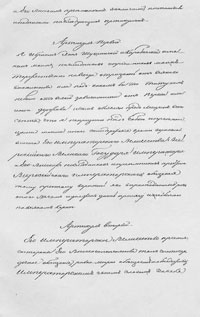 The treaty of 14 May 1805, signed between Ibrahim khan of Karabakh and Russian General Tsitsianov, on the transfer of the Khanate to Russian rule
The treaty of 14 May 1805, signed between Ibrahim khan of Karabakh and Russian General Tsitsianov, on the transfer of the Khanate to Russian rule Karabakh was devided into 14 mahals (districts): Talish, Keloniya, Khachin, Hajiislam, Kanan, Dizakh, Varand, Otuzikiler, Iyirmidordler, Araspar, Karachorli, Zangezur, Sisian and Mehriguney. The peace that came to Karabakh after the Russian conquest led to a population explosion, the development of production and the start of a revival.
Russia settles Armenians in Karabakh
Armenians from Iran, South Azerbaijan and Turkey were resettled in large numbers in the South Caucasus, including Karabakh, during the Russo-Persian wars (1804-13 and 1826-28) and in subsequent years. Their number increased every year. During the Russo-Persian war of 1826-28 alone, 18,000 Armenian families from Iran and the southern territories of Azerbaijan settled in Northern Azerbaijan, including Karabakh. [11, p.39] The Turkmenchay peace treaty was signed at the end of the Russo-Persian war of 1826-28 in which Russia was victorious. The treaty allowed the unimpeded settlement of Armenians from Iran to the territories of Northern Azerbaijan, including Karabakh, occupied by Russia. "In two years, 1828 to 1830, we resettled 40,000 Persian and 84,000 Turkish Armenians in the Trans-Caucasus, giving them the treasury´s best land in Yelizavetpol and Irevan governorates, where the Armenian population was negligible, and more than 200,000 desyatins (218,000 hectares) of treasury land was allocated to them." [12, pp.59-60] The quotation shows that Armenians were also settled in the Yelizavetpol Governorate, which included Karabakh, and that prior to this the number of Armenians there had been "negligible".Of course, the allocation of fertile land to the migrants worried the local Azerbaijani peasants, as they had lost some of their land. Russian writer and diplomat Alexander Griboyedov, who took part in the process, commented: "We also discussed incentives for the Muslims to reconcile them to the current burden, which will not last long, and free them of the fear that the Armenians will own in perpetuity the land where they were first allowed to settle. We have also discussed this … with the khans who visited me here." [13, p.341] Even after the mass migration of Armenians to the Trans-Caucasus, including Karabakh, the number of Armenians was still far smaller than the number of Azerbaijanis there.
According to the census in 1832, 13,965 of 20,546 families in Karabakh were Azerbaijani and 6,491 Armenian. [10, p.167] In 1823 to 1827 Azerbaijanis made up 91 per cent and Armenians 8.4 per cent of the population. As a result of tsarist Russia´s migration policy, in the early 1830s the number of Azerbaijanis fell to 64.8 per cent, while the number of Armenians increased to 34.8 per cent. [14, p.25]
In 1886 the Shusha District (uyezd) consisted of almost the whole current territory of Mountainous Karabakh; as a consequence of the migration, Armenians already made up 58.2 per cent of the population and Azerbaijanis 41.5 per cent. In 1915 in the Shusha uyezd 77,189 of the population of 171,954 were Azerbaijanis and 94,785 were Armenians [15, pp.48-61], and in 1916 Azerbaijanis made up 78,226 of the 180,832 population and Armenians 96,018. [16, pp.230-233]
Economy develops in Karabakh
The social structure of the Karabakh population was not homogeneous either. Members of the khan´s family, nobility, clergy, government officials, craftsmen, merchants, peasants, teachers, medical workers, cultural figures and others lived in Karabakh. According to the data, in the early 1830s 1,190 families belonged to the nobility in Karabakh. [10, p.268] The clergy consisted of 207 Azerbaijani and 145 Armenian families.Fifty-six noble families, 64 clergy families and 21 Christian (Albanian) clergy families lived in Shusha, the centre of the Karabakh Khanate, in 1830. [10, p.307] At that time 200 families in the city engaged in trade and 266 in handicrafts. [17, p.21] The city´s economic revival, the start of capitalism and its development influenced the social structure of the population too. The Russia-wide population census of 1897 registered in the city 2,272 aristocrats, 270 clergy, 1,516 merchants, 2,738 craftsmen, 97 state officials, 334 military servicemen, 121 teachers, 40 medical and public health workers, 200 permanent workers and others [17, p.22], while in the Shusha District it registered 7,588 nobles, 1,184 clergy, 597 merchants, 17,344 petty bourgeois, 107,861 peasants and 5,086 of other classes. [17, p.23]
Comparison of the figures shows that by the end of the century the number of craftsmen had increased since the 1830s by a factor of 10 and the number of merchants by a factor of 7.5. The aristocratic life in Shusha, which was the most attractive city in the Yelizavetpol Governorate, drew most of the nobles and landlords of Shusha and the other districts (uyezds) of the governorate. As a result the number of aristocrats living here had also increased considerably by the end of the 19th century - by a factor of 40 in comparison with the 1830s.
The population of Shusha District engaged in husbandry, horticulture, sericulture, arable farming and stock-breeding. They grew wheat, barley, millet, cotton, flax and tobacco. Wheat, barley, flax and spelt were mainly grown in the upland areas. In the mid-19th century in the Karabakh Province more than 22,000 desyatins (23,980 hectares) of wheat were sown annually, 11,000 of barley, 250 of spelt, 400 of millet, 2,250 of rice, 550 of cotton, 50 of flax and no more than five quarters of sesame; up to 215 desyatins were sown to tobacco and yielded up to 450 poods (7,371 kg) every year. Since part of the land was left fallow every year, apart from Bargushat, Chaundur and other valleys which did not have a fallow period, the whole area of arable land was estimated at around 100,000 desyatins.
The most fertile land in Karabakh was considered to be along the Akeri River - in Bargushat, Chaundur and elsewhere - in the valleys of the rivers Khachen, Terter and Gargar and also in Zangezur, Pussian, Sisian and Dizak mahals (districts).
In 1840 the Karabakh Province was renamed the Shusha District (uyezd). [18, p 542] In 1846 tsarist Russia formed a new administrative division in the Caucasus. Under the new division the Shusha District (uyezd) became part of the Shamahki Governorate (guberniya). In 1868 the new Yelizavetpol Governorate was established and included the Shusha District.
Most of the urban population of Shusha were engaged in handicrafts, trade and different types of production up to the factory level. The geographic location of Shusha was not favourable for the development of agriculture, so Shusha developed as a city of handicrafts and trade from the very outset.
Handicrafts developed in subsequent years. From 1850 to 1900 the number of craftsmen more than doubled. Some branches of handicrafts rose not only to small-scale commodity production, but even to factory-scale manufacturing. This was the period of the rise and development of capitalist relations in the Azerbaijani economy. In this period stratification deepened among the craftsmen in Shusha. Some craftsmen became rich and expanded their production. In the early 1860s 16 artisan enterprises worked in Shusha with an annual production worth 78,000 roubles. [20, p.322] But some sectors that had previously been important weakened because of a lack of demand and gave way to sectors for which there was greater demand.
The artisans produced commodities, in particular cloth, which was one of the oldest and widest spread sectors in Azerbaijan. In the first half of the 1890s three small establishments produced felt. One of them was founded in 1876 and belonged to Kerbelayi Abbas oglu. The second was established in 1885 and belonged to Usta Karam oglu. And the third was launched in 1887 and its owner was Kerbelayi Kasum oglu.
In the period being studied Karabakh was a very important centre of carpet production and employed mainly Azerbaijanis. Karabakh carpets were distinguished by their colours, weaving technology and design. In Caucasian and other markets Shusha carpets were known as "Karabakh carpets". Researchers studying carpet weaving have specified 11 Karabakh carpet designs. In the 1880s-90s carpet weaving was in first place in terms of both volume and quality of production. "Karabakh, first of all, is the leader in artistic taste, customers and buyers, and has the largest market: the best master craftswomen, who set the fashion for whole of carpet production in the Trans-Caucasus, worked here." [22, p.59]
Carpet production greatly increased in Karabakh in the 1890s as a result of growing demand in foreign markets which led to an expansion in carpet exports. This period also saw a rush of customers from abroad. "Foreigners bought old carpets at very high prices and sent them abroad… with the new demand for old carpets, the number of carpet producers began to increase and prices for carpets rose too."
In the 1870s factories with steam engines were founded in Karabakh [24], which brought silk spinning to the factory level. Sericulture developed in 250 villages in Shusha District. Most of the silk production enterprises in Karabakh were located in Shusha, but some were in Jebrail and Javanshir districts.
Joint-stock companies began to be established in light industry in Azerbaijan in the late 19th century. In 1890 silk spinning joint-stock companies were founded in Karabakh by local capitalists and had their management boards in Shusha.
In 1914 the Shusha mutual-credit agricultural company was founded in Karabakh. [25] It was the major provider of credits to Shusha industrialists, merchants and craftsmen. Another bank, the Shusha branch of the Tbilisi division of the Volga-Kamskiy Commercial Bank, opened in 1910. [26, p.79]
The 19th and early 20th centuries were marked by the revival of trade in Karabakh and Shusha. The caravan routes across the Trans-Caucasus, which passed through Shusha, had an influence on this revival. Shusha had commercial relations with Russia, Iran, Turkey and a range of European countries. The products of Shusha craftsmen were valued not only in the city itself, but also abroad.
Armenians lay claim to Karabakh
On 28 May 1918 the Azerbaijan Democratic Republic was founded and included Karabakh. After Turkish forces left Karabakh and Azerbaijan as a whole in November 1918, British forces replaced them under the terms of the Mudros treaty. [37] Inter-ethnic relations became extremely strained in Karabakh in 1918 with 157 settlements suffering serious damage as a result. [38]At this time the Armenian Dashnak government insistently laid claim to Zangezur, Jebrail and Kazakh. The Azerbaijan Democratic Republic´s minister of internal affairs told the government in a report that the Dashnaks had been campaigning in the mountainous areas of Zangezur, Shusha and neighbouring districts, urging the people to break away from Azerbaijan and join the newly forming Ararat Republic. The minister continued that the situation had become aggravated by the advent of Armenian forces led by Andranik who was quite open about his aim - to separate Karabakh from Azerbaijan and annex it to Armenia. [39, p.138]
As a result of the prevailing situation, the minister considered it essential "to establish the position of temporary governor general for the area of the Shusha, Jevanshir and Jebrail districts with residency in Shusha." [39, p.139] The temporary governor general had the following functions: establishing law and order in the districts once and for all, organising the local authorities, supplying food to the refugees and giving them general help, combating epidemics both amongst refugees and the native population, and the return of refugees to their native lands once peace had been restored. [43, p.139] Concerned about this, Dashnak Armenia´s foreign minister informed the commander of the British forces, Gen Thomson, that it was important to stop the functions of the governor general, as "the local population and parliament consider this territory an inseparable part of our Republic, the country is governed by a local ethnic Council on behalf of the Armenian government and is granted full authority. The Armenian government has its commissar in Geryusakh and pays all administrative expenses." [39, p.139] These documents are evidence of the strained political situation in the region. Most understood that the mountainous part of Karabakh, inhabited mainly by Armenians, was completely dependent on the lower part. We would like also to note that a decision of the 7th Congress of Karabakh Armenians in August 1919 declared all clashes to be disastrous for all the peoples of Karabakh and stated the importance of the co-existence of the Armenians and Muslims of this region within the Azerbaijani Republic.
LITERATURE
1. Acts collected by Caucasus Archeological Commission volume I, p. 19
2. X.M. Ibragimbeyli, Rossiya i Azerbaidzhan v pervoy treti XIX v. Moscow, 1965
3. Akhmed bek Dzhavanshir, O politicheskom sushshestvovanii Karabakhskogo khanstva (s 1747 po 1805 gg.), Baku, 1961
4. N. Dubrovin, Zakavkazye 1803-1806 gg., SPb, 1866
5. Mirza Dzhamal Dzhavanshir, Istoriya Karabakha, Baku, 1959
6. A.A. Bakikhanov, Gulistan-Iram, Baku, 1926
7. V. Popo, Perviye dobrovoltsi Karabakha v epokhu vodvoreniya russkogo vladichestva, Tbilisi, 1902
8. Prisoedineniye Azerbaidzhana k Rossii i ego progressivnoye posledstviye v oblasti ekonomiki i kulturi (XIX, nach. XX vv.)
9. Acts collected by Caucasus Archeological Commission, Tbilisi 1867, volume II, p.19
10. Kolonialnaya politika Rossiyskogo Tsarisma v Azerbaidzhane v 20 -60-kh gg. XIX v. Moscow, 1936, Ch. I
11. Obozreniye Rossiyskikh vladeniy za Kavkazom, Ch.III, SPb, 1836
12. SMIEBQK, volume IV
13. K.N. Shavrov, Novaya ugroza russkomu delu v Zakavkazye: predstoyashchaya rasprodazha Mugani inorodtsam SPb, 1911
14. A.S. Griboyedov, Sochineniya v dvukh tomakh, Moscow, 1971
15. I. Shopen, Istoricheskiye pamyatniki sostoyaniya Ar. oblasti SPb, 1952
16. Kavkazskiy kalendar na 1896 g.
17. Kavkazskiy kalendar na 1915 g. Obozreniya ros. vladeniy za Kavkazom, Ch.III.
18. Pervaya vseobshchaya perepis naseleniya Rossiyskoy imperii 1897 g. Yelizavetpolskaya guberniya, SPb, 1904
19. Kavkazskiy kalendar na 1852 g.
20. TsGIA Gruz. SSR, collection 4, catalogue 7, case 130, pp.49-52
21. TsGIA SSSR, collection 1268, catalogue 10, case 108, p. 322
22. P.A. Orlov, Ukazatel fabrik i zavodov okrain Rossii - SPb, 1895
23. A.S. Piralov, Kratkiy ocherk kustarnikh promislov Kavkaza, 1900
24. Kavkazskiy kalendar na 1904 g., Tbilisi, 1903
25. TsGIA SSSR, collection 1268, catalogue 20, case 146, p. 169
26. Shushinskiy listok, 17 July 1914
27. T.T. Veliyev, Promishlennost i proletariat Azerbaidzhana v period imperialisma, Baku, 1897
28. Z.A. Kafarova, Formirovaniye proletariata v uyezdakh Azerbaidzhana vo vtoroy polovine XIX veka, Avtoref. Dis, Baku, 1987
29. Ocherki istorii Kommunisticheskoy partii Azerbaidzhana, Baku, 1985
30. Trudi Azerbaidzhanskogo filiala Instituta Marksizma-Lenininsma pri TsK KPSS, Baku, 1855, T.19
31. Istoriya Kommunisticheskoy partii Azerbaidzhana
32. A. Sarkisov, Leninskaya Iskra i bolshevistichiskaya pechat Zakavkazya, Yerevan, 1961
33. Z. Ibrahimov, Revolyutsiya 1905-1907 gg. v Azerbaidzhane, Baku, 1955
34. P.L. Valuyev, Bolsheviki Azerbaidzhana v pervoy russkoy revolyutsii, Baku, 1963
35. Perepiska V.I. Lenina i rukovodimikh im uchrezhdeniy RSDRP c partiynimi organizatsiyami 1905-1907 gg, Moscow, 1986, T.III, KN.2
36. TsPA Azerbaidzhanskaya filiala IML pri TsK KP Azerbaidzhana, f. 276, op.I, d. 426
37. P. Aliyev, Borba bolshevikov Karabakha za pobedu sovetskoy vlasti, Baku, 1963
38. TsGIA Arm. SSR, collection 221, catalogue 1, case 44, p. 22
39. Elm newspaper, 12 August 1989
40. Izvestiya AN AzSSR, seriya istorii, filosofii, prava, 1989, 2
41. K istorii obrazovaniya Nagorno-Karabakhskoy avtonomnoy oblasti Azerbaidzhanskoy SSR (1918-1920), Dokumenti i materiali, Baku, 1989
